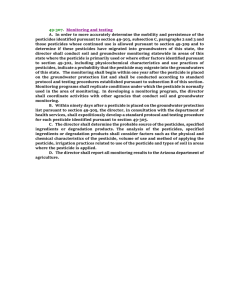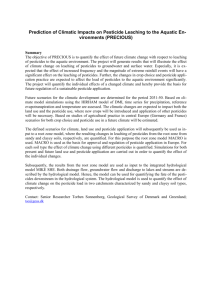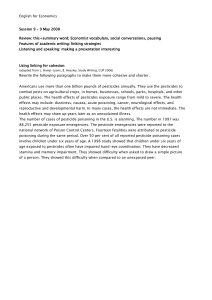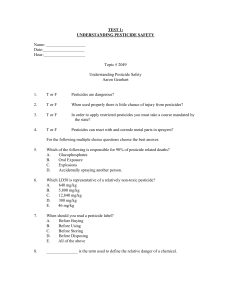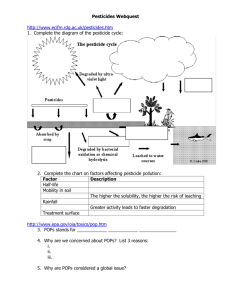Practice Test Answers
advertisement
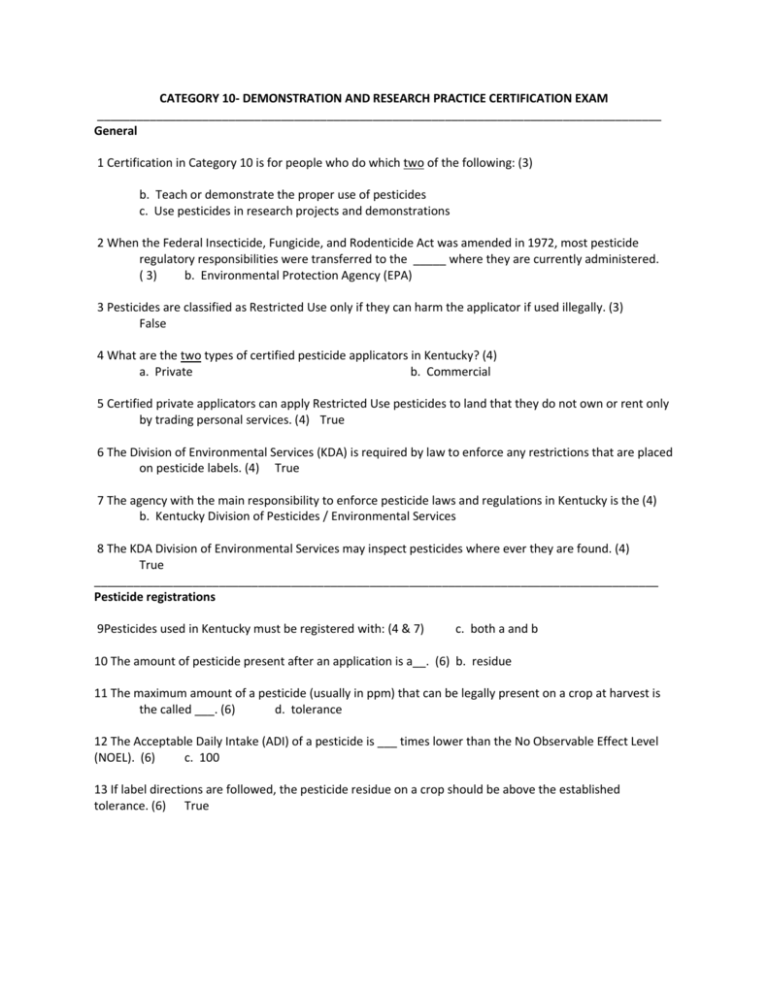
CATEGORY 10- DEMONSTRATION AND RESEARCH PRACTICE CERTIFICATION EXAM ______________________________________________________________________________________ General 1 Certification in Category 10 is for people who do which two of the following: (3) b. Teach or demonstrate the proper use of pesticides c. Use pesticides in research projects and demonstrations 2 When the Federal Insecticide, Fungicide, and Rodenticide Act was amended in 1972, most pesticide regulatory responsibilities were transferred to the _____ where they are currently administered. ( 3) b. Environmental Protection Agency (EPA) 3 Pesticides are classified as Restricted Use only if they can harm the applicator if used illegally. (3) False 4 What are the two types of certified pesticide applicators in Kentucky? (4) a. Private b. Commercial 5 Certified private applicators can apply Restricted Use pesticides to land that they do not own or rent only by trading personal services. (4) True 6 The Division of Environmental Services (KDA) is required by law to enforce any restrictions that are placed on pesticide labels. (4) True 7 The agency with the main responsibility to enforce pesticide laws and regulations in Kentucky is the (4) b. Kentucky Division of Pesticides / Environmental Services 8 The KDA Division of Environmental Services may inspect pesticides where ever they are found. (4) True ______________________________________________________________________________________ Pesticide registrations 9Pesticides used in Kentucky must be registered with: (4 & 7) c. both a and b 10 The amount of pesticide present after an application is a__. (6) b. residue 11 The maximum amount of a pesticide (usually in ppm) that can be legally present on a crop at harvest is the called ___. (6) d. tolerance 12 The Acceptable Daily Intake (ADI) of a pesticide is ___ times lower than the No Observable Effect Level (NOEL). (6) c. 100 13 If label directions are followed, the pesticide residue on a crop should be above the established tolerance. (6) True ______________________________________________________________________________________ Types of pesticide registrations 14 The EPA can grant a/an ___ to collect information needed for initial registration or to add a new use to a pesticide label. (7) b. Experimental Use Permit (EUP) 15 Unless prohibited by the pesticide label, which of the following uses is/are permitted under Section 2 ee of the amended Federal Insecticide, Fungicide, and Rodenticide Act (FIFRA)? (7) d. all statements are true 16 The major task of the Interregional Research Project 4 (IR-4) program is a means of gathering residue data for pesticide use on minor or specialty crops that do not appear on pesticide labels. (8) True 17 A 24-c State Local Needs (SLN) label allows the KDA to resister any unregistered pesticide for some uses that are not on the existing label. (8) False 18 SLN labels can be used to register products to control pest problems when there are no EPA-registered pesticides for that use, or if there is not an adequate supply of registered pesticides. (9) True 19 An Emergency Registration (Section 18) label allows the use of an unregistered pesticide in an emergency situation for which there are no registered pesticides. (9) True 20 Which of the following exemptions is appropriate for a Section 18 Specific Exemption to control a pest? (9) d. all statements are true 21 The EPA cannot cancel or reclassify a pesticide once it has been registered. (9) True False ______________________________________________________________________________________ Demonstration and Research 22 The inherent variability that occurs between experimental units or plots is called the ____. (11) a. Experimental error 23 A ____ is a group of experimental units or plots in which each treatment occurs the same number of times. (11) d. Block 24 A factor being tested in an experiment is called _____. (11) a. Treatment 25 An experiment with 3 treatments and 1 control that is replicated 4 times would require ___ plots. (12) d. 16 26 The plot above is an example of a ___ experimental design. (12) a. Randomized Complete Block ______________________________________________________________________________________ Calibration 27 A field plot that is 43.56 ft wide by 100 ft long contains __ acre(s). (1 ac = 43,560) (13) b. 0.1 28 How much water should you collect in 30 seconds from a nozzle that is designed to have an output of 0.5 gal of spray per minute? (13) 1 gal = 8 pts (13) b. 2 pts 29 Small errors in calculating rates for small plot studies will have minimal impact on research results. (13) False 30 An applicator can treat small plots at the rate of 1,000 square feet of area in 1 minute. By walking faster, he or she can treat at the rate of 1,000 square feet in 45 seconds and get done quicker. How will the faster walking pace affect the amount of pesticide applied if no sprayer adjustments are made? c. decrease the amount applied and may cause poor control ______________________________________________________________________________________ Pesticide Modes of Action 31 Resistance should not develop if you continue to use pesticides with the same mode of action against a pest. (14) False 32 In general, symptoms from herbicide activity will be most obvious ___. (15) d. where the product accumulates 33 Some plants may not killed by a herbicide because __ (15) d. any of the above 34 Herbicides that inhibit germination or seedling growth are most effective as post-emergence herbicides. False 35 Under some conditions, plants can be killed by a herbicide that usually does not affect them. (15) a. True 36 All insecticides are nerve poisons. b. False 37 Fungicides that can destroy fungi that have already invaded plant tissues are called ____. (16) c. eradicants ______________________________________________________________________________________ Pesticide toxicity 38 The toxicity of a pesticide is a measure of its: (17) a. ability to cause harmful effects 39 The chronic toxicity of a chemical is measured by its LD50. (17) b. False 40 A chemical with an oral LD50 value of 10 is less toxic that a chemical with an LD50 value of 350. toxic? (17) b. False 40 Acute effects of pesticide poisoning usually occur within 24 hours of exposure. (17) a. True 41 Long term exposure to a chemical with low toxicity can be as dangerous, or more dangerous, than short term exposure to a chemical with higher toxicity. (17) a. True 42 ____ contact is the most common way applicators are exposed to pesticides. (18) b. Dermal 43 All surfaces of the body absorb pesticides equally well. (18) b. False ______________________________________________________________________________________ Pesticides in the Environment 44 Match the following terms and definitions (19) a Adsorption c Degradation b Transfer a. Binding to the soil b. Movement from place to place c. Breakdown 45 Pesticides that are tightly bound to soil particles are very likely to leach into the groundwater. (20) False 46 Pesticides that are not tightly bound to the soil are very likely to move off site in runoff water. (20) False 47Which of the following factors does not affect the movement of a pesticide into the ground water? c. LD50 48 Karst systems are found in regions characterized by limestone and dolomite with fractures and solution channels. (21) True 49 The potential for pesticides entering groundwater in increased by which factors? (21) d. all of these 50 Sinkholes and solution channels are features of physiographic regions characterized gravel, sand, silt and clay. (21) False 51 ____ is the downward movement of a pesticide through the soil. (21) a. Leaching 52 What percent of Kentuckians living in rural areas depend on groundwater as their water source? (21) d. over 85% ______________________________________________________________________________________ IPM and Pest Control 53 Which of the following is not a part of Integrated Pest Management (IPM)? (21) b. preventive sprays 54 IPM does not allow the use of pesticides at any time. (22) False 55 The number or density of a pest at which a control measure should be taken to prevent economic loss is called the __ . (22) b. Economic threshold 56Preventive treatment will always reduce the chances of unneeded pesticide applications and unprofitable control costs. (22) False 57 Match the practice on the left with the appropriate pest control method on the right. (22) (You may use some answers more that once) b a a a e d c Cultivation of a field for weed control Crop rotation in a field Use of a disease resistant variety Plant wheat after frost-free date Encourage natural enemies in crops Follow quarantine procedures Drought reduced plant disease activity a. b. c. d. e. Cultural control Mechanical control Natural control Regulatory control Biological control ______________________________________________________________________________________ 58 Certified applicators must keep records of pesticide applications for __ years. c. 3 59 Your pesticide license is valid for 3 years and expires on December 31 True 60 Your pesticide certification is valid for 3 years and expires on December 31 of the last year. True 61 Which one of the following regulate pesticides and their use in the state? b. KRS-217b – Ky Pesticide Use and Application Act 62 Which of the following is the federal law regarding pesticides? b. Federal Insecticide Fungicide and Rodenticide Act FIFRA 63 How many continuing education credits are needed during the 3-year period to maintain your certification? 12 64 How long must you keep records of all pesticide applications? (General and Restricted Use? 3 years



